Gaza Aid Plane Ordered To Remove Mahsa Amini's Image
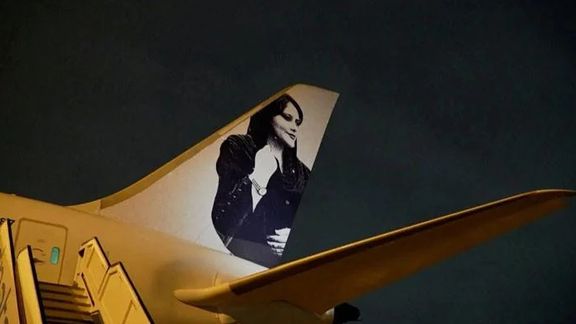
Argentinian filmmaker and former pilot Enrique Piñeyro was forced to remove the image of Mahsa Amini from his Boeing 787 to land in Egypt delivering aid to Gaza.

Argentinian filmmaker and former pilot Enrique Piñeyro was forced to remove the image of Mahsa Amini from his Boeing 787 to land in Egypt delivering aid to Gaza.
The social activist unveiled the livery to raise awareness over the crisis in Iran following the "Woman Life Freedom Movement" movement last year which challenged the regime and its religious authority.
The nationwide protests were sparked by the death in morality police custody of 22-year-old Mahsa Amini in September 2022, now an icon of the uprising.
“To fly a humanitarian cargo to El Arish for Gaza, the Egyptian government would not allow the livery with the photo of Mahsa Amini and the legend,” Piñeyro wrote on X.
The Boeing aircraft also featured an image of Iranian footballer Amir Reza Nasr Azadani and the following slogans: “No woman should be forced to cover her head. No woman should be killed for not covering her head. No man should be hanged for saying this”The footballer was sentenced to 21 years in prison after he was arrested during the protests.
Enrique Piñeyro also helps Ukrainian refugees get to safety, using a Boeing 787 that he owns and operates as part of Solidaire, his charitable organization.
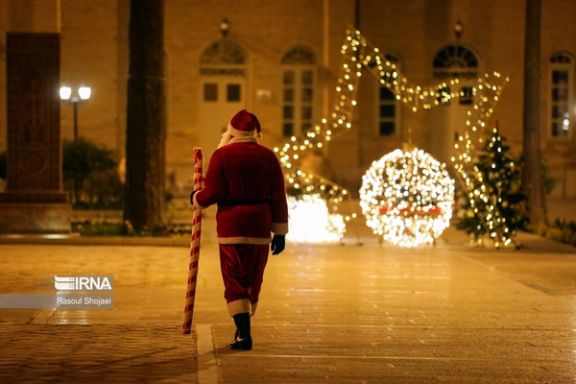
Hundreds of Iranians rushed to an Armenian church in Esfahan on Sunday to celebrate Christmas, which has become popular among Muslims over the past two decades.
Videos posted on social media depict a large crowd, mainly composed of young non-Christians, trying to enter the historic Vank Cathedral. This cathedral is a major tourist attraction in the city, but on that day, it had to close its doors to the public an hour earlier than usual. Later, the police used force to disperse the youths who were singing and dancing in the street outside the church.
There was no Christmas service held at the cathedral, because unbeknownst to those who had gathered outside, Armenians celebrate the birth of Christ on January 6, following the tradition of Eastern Orthodox Christians.
Crowd trying to force doors of Vank Cathedral open and chanting “Open the door, Jesus!”
For several years, pundits have suggested that the rising popularity of Christmas in an Islamic country like Iran is a collective response to the government's attempts to promote Shiite mourning ceremonies over the celebration of happiness in society. This has also led to a growing disregard for ancient Iranian festivals such as Nowruz (New Year), Yalda (Winter Solstice Festival), and Charshanbeh Souri (end of year bonfire festival), all of which are traditionally associated with joyous celebrations.
“What is important to people is life and happiness. [Celebration of Christmas and other western holidays] is…a reaction to traditional [Shiite] culture,” philosopher and university professor Bijan Abdolkarimi told local media in 2020.
Like Valentine’s Day and Halloween, the popularity of Christmas has been on the rise among Muslim Iranians in the past two decades.
Photos published by Iranian media this year show shop windows with beautifully decorated Christmas trees, Santa Clauses, and Christmas accessories, as people, even women in long black veils and their children, taking selfies with the decorations.
Police using violence against a man watching young people’s dance outside Vank Cathedral
Arguing that celebration of Christmas by Muslims has nothing to do with seeking the truth of Christianity or the actual celebration of the birth of Christ, Abdolkarimi called the reaction of the Iranian society “a means of expressing disgust and hatred” of the prevalence of religious dogmatism and control.
For hundreds of years, Esfahan, Iran's third-largest city after Tehran and Mashhad, has been home to a large Armenian community and over a dozen historical churches.

Like some other historical Armenian and Assyrian churches in other parts of Iran, the Vank Cathedral, established in 1606 in Esfahan’s historical New Julfa District, is open to the public on certain days.
Most contemporary churches, however, do not open their doors to non-Christians, particularly during worship, for the fear of being accused of encouraging conversion of Muslims to Christianity. Conversion from Islam could bear a death sentence to the convert.
Armenians are the biggest non-Muslim religious minority in Iran. There are around 120,000 Armenian and Assyro-Chaldean Christians in Iran. Unlike converts to Christianity, they enjoy some degree of freedom of worship and have their own representatives in the parliament.
Importing Christmas accessories, mainly from China, has been banned for several years and what is on offer in shops is illegally imported. Iranian media have for several years reported that Muslim families buy most of these commodities.
“There is an unwritten rule [about selling Christmas accessories] ... They may say that it is preaching Christianity…We are always in doubt. We do not know what is legal and what is not,” the owner of a shop in Tehran told Ensaf News when asked about getting into trouble for selling Christmas accessories.
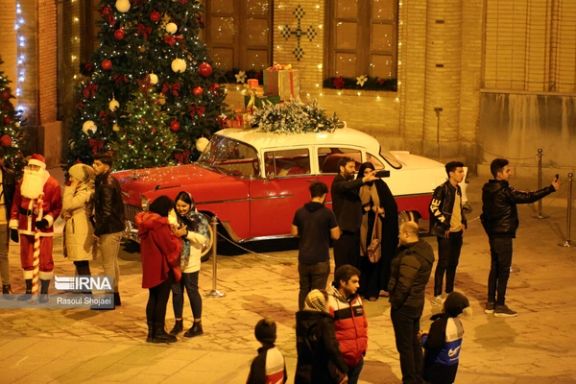
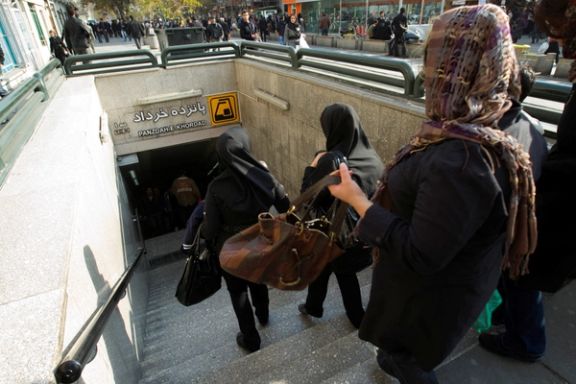
Hijab enforcers are searching citizens' personal belongings at Tehran’s subway stations "under the pretext of warnings regarding hijab".
Jamaran News website reported that plainclothes officers present at metro stations have searched people’s backpacks and conducted "unauthorized filming of people with pocket and tripod cameras, checking their mobile phones without written permission, and taking pictures of their registry codes."
The website quoted one of the officers as saying that the measures came from the "orders of the Ministry of Interior, as well as the support of the Tehran Municipality".
It comes amidst growing crackdowns on hijab enforcement as the regime continues to lose the battle begun during last year's Women, Life, Freedom protests. There have been reports of Security Police (FARAJA) assisting hijab enforcers by using cameras to identify women without headscarves.
Outlets including Farhikhtegan have branded the moves a "breach of privacy". "Recording images of passersby violates people's right to privacy," the publication wrote in November.
Authorities did not present a clear stance on the issue as the Iranian Interior Minister Ahmad Vahidi denied issuing any permits for the enforcers of the hijab and referred to them as "spontaneous groups," in early November.
On November 29, Ahmad Vahidi retracted his initial statement and defended the practice of government agents photographing citizens in public places, describing it as "natural." He responded to public outrage by comparing traffic control cameras, asserting that capturing images of those violating rules is a common and convenient practice.

A minimum of 50 businesses in Iran's religious city of Qom have been closed down for non-compliance with compulsory hijab regulations.
Mehdi Ali-Babaei, the head of the secretariat of the Dey 19 cultural and social headquarters in Qom, revealed on Wednesday that “an additional 65 businesses received written and text message warnings regarding their failure to adhere to the hijab regulations.”
The crackdown on businesses is part of a broader response by the Islamic Republic to civil protests against mandatory hijab, which have gained momentum following the death of Mahsa Amini in custody last year. Amini's arrest, labeled as "unfitting hijab" by morality police, triggered months of protests across the country.
In recent months, authorities have implemented stringent measures to enforce hijab rules, including the impounding of cars if passengers defy hijab regulations. Additionally, businesses such as cafes, restaurants, and shopping malls have been shut down for non-compliance, and celebrities who defy hijab rules have been barred from acting in films.
On September 20, the Iranian parliament approved the "Chastity and Hijab" bill, which proposes severe penalties for opponents of compulsory hijab. Originally drafted by the government and later modified by the parliament's hardliners, the legislation suggests various penalties, including substantial fines for women who do not adhere to the prescribed dress code of the Islamic Republic. This dress code mandates a headscarf covering all hair and shoulders, a loose long tunic with long sleeves, and trousers that cover the legs below the ankles.

While Iran’s ruler Ali Khamenei says he wants a high-turnout election in March, his followers show no intention to give a fair chance to their rivals, the Reformists.
In recent days, several politicians have suggested that the Reformists, who have been cut out the previous two elections, should nevertheless urge the apathetic voters to go to the polls.
Reformist groups feel the call for their participation is meaningless as nearly all their well-known candidates have been already disqualified by the Interior Ministry in the first round of a non-democratic vetting scheme. While the interior ministry can disqualify any person without offering a convincing reason, the Guardian Council takes a second stab and can equally disqualify more candidates.
Former lawmaker Morteza Alviri, a Reformist politician, told Khabar Online that key Reformist politicians such as former President Mohammad Khatami, Former Public Prosecutor Mohammad Khoiniha and former Interior Minister Abdollah Nouri's silence about the elections is in fact their protest action against the current situation.
Alviri, who served in parliament twice in the 1980s, explained that many prominent Reformist figures are reluctant to register their candidacy due to skepticism about the biased vetting system controlled by ultraconservatives. He added that the exclusion of Reformists in recent elections has left them disheartened. Despite Khamenei's call for political participation, Alviri believes that any Reformist who advocates for it risks damaging their reputation.
What Alviri did not mention is that, while Khamenei mildly criticized the Interior Ministry for disqualifying Reformist figures like the current MP for Tabriz, Massoud Pezeshkian, he refrained from advising the Guardian Council to approve the qualifications of any remaining Reformist candidates. This is likely because there are no significant Reformist candidates left for the Guardian Council to vet.
Other pro-reform political figures, such as Mohsen Hashemi, who say they are waiting for the Guardian Council's decision, belong to centrist parties such as the Executives of Construction.
These parties were not that popular with voters in the previous elections when they won less than 3 percent of the votes and the previous Presidential elections in which their members and supporters refused to work for the party's candidate former Central bank Governor Abdolnasser Hemmati. The former leader of the Executives of Construction Party Hossein Marashi has told the press that it was a mistake not to vote for Hemmati. it was a mistake that led to a major defeat for the party."
Some moderate figures such as former President Hassan Rouhani have said that if the majority of the people refuse to take part in the upcoming elections, that would be a great gift to hardliners who currently control the government and the parliament. However, Rouhani who appears to be heeding Khamenei's call for advocating participation, is said not to have enough suitable people around him to fill the list of 30 candidates for Tehran. His party members said he might give a list of only 16 moderate politicians.
Former reformist President Mohammad Khatami in previous years played a key role in encouraging the people to go to vote, but as Alviri has pointed out, the people are no longer so naïve as to listen to such advice. Khatami who is also sulking with the regime that has ignored him for so many years, is now even questioning the regime's legitimacy. He said in a recent statement to a women's human rights gathering in Tehran: "A political regime can be justified only when it can be reformed, and that is when it respects human dignity and gender equality."
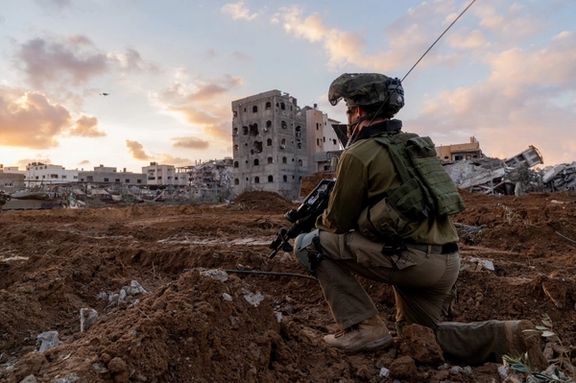
The Islamic Revolutionary Guard Corps (IRGC) says the October 7 attack by Hamas on Israel was a retaliatory action for the assassination of Qasem Soleimani.
According to the IRGC-affiliated Fars News Agency, in a press conference held on Wednesday, Ramezan Sharif, the spokesperson for the IRGC said "The Al-Aqsa Storm was one of the retaliations of the Axis of Resistance against the Zionists for the martyrdom of Qasem Soleimani," the man behind Iran's proxy activities across the region.
The claims contradict the regime's usual stance which has distanced itself from the attacks even though it has supported them and celebrated the tragedy. Tehran asserts Hamas acted independently, in spite of years of huge financial and military support given to the Gaza based militants from Tehran.
The terror attack which saw at least 1,200 mostly civilians killed and 240 more taken hostage, was the most deadly single day for Jews since the Holocaust and has since seen an escalation of tensions from Iran's proxies across the region, both attacking Iran and the US, in addition to blockading the Red Sea.
Soleimani, a key figure in Iran's external military and intelligence operations, was killed in a US drone strike near Baghdad International Airport on January 3, 2020.
Soleimani was accused by then-President Donald Trump of actively planning attacks on American diplomats and service members in the region. He played a crucial role in supporting and organizing militant proxy forces, including Lebanese Hezbollah and Iraqi Shiite militia groups.